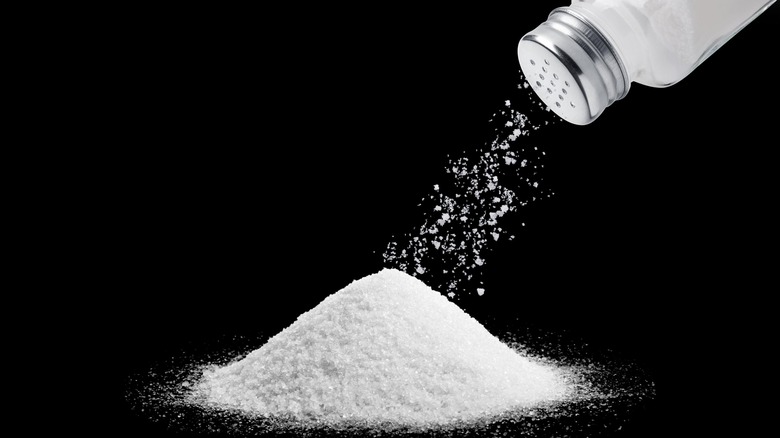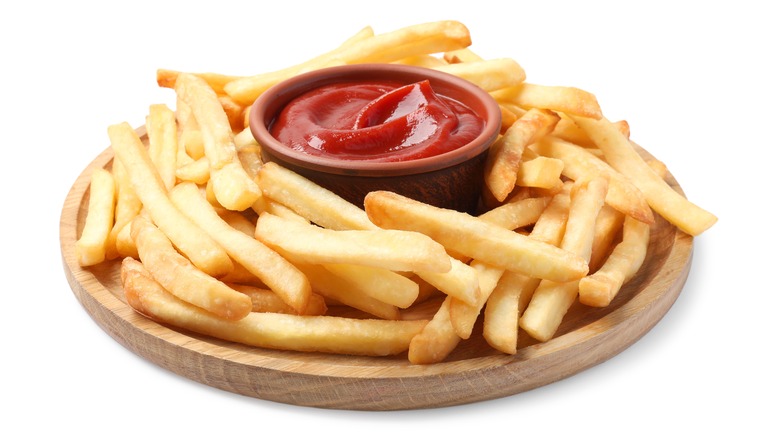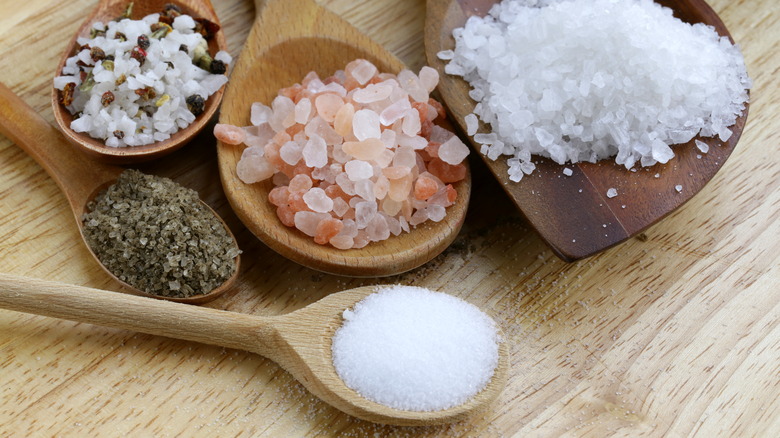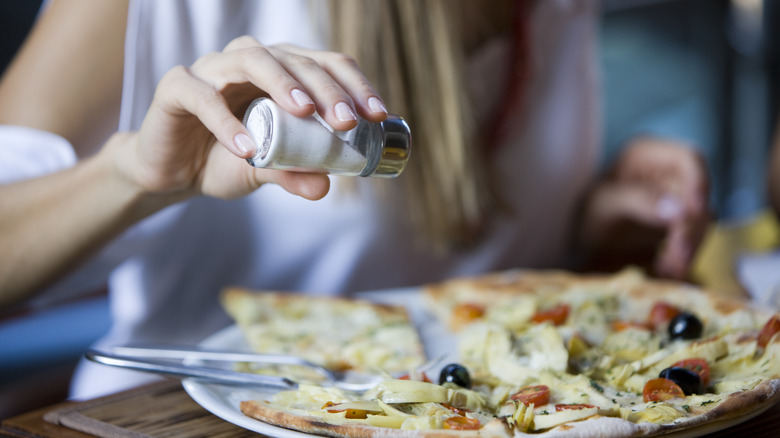False Facts About Salt You Thought Were True
Popular for its ability to enhance the natural flavors of ingredients, salt is a culinary staple in most kitchens. Whether you're sprinkling it on top of a dish or mixing it into recipes, a little bit of salt can make a big difference in how your food tastes. And it's not just about making dishes saltier. The ubiquitous seasoning can balance and bring out the flavor profiles of other ingredients, making them taste more vibrant. This is why even recipes for sweet treats such as cakes and cookies often call for a pinch of salt.
Although humans likely utilized salt in various forms before this period, the oldest documented instances of salt processing can be traced back to roughly 6,000 years ago. During this period, the inhabitants of present-day Romania were already harvesting salt by boiling spring water. Similarly, researchers have found a salt production site in China from approximately the same era. Today, salt remains as popular as ever, with Americans consuming an average of 8.9 grams of the dietary mineral per day (via World Population Review).
Salt's popularity spans the globe, but so do the myths surrounding it. Interested in uncovering the truth about this enduring kitchen staple? Read on!
False: Even small amounts of salt are unhealthy
The perception that even small amounts of salt are unhealthy is primarily caused by its high sodium content. In fact, sodium is one of the two main components of salt, making up 40% of the seasoning — the other 60% comes from chloride. Excessive sodium intake has been linked to various health issues, including high blood pressure, heart disease, gastric problems, and obesity. The World Health Organization presents a grim picture, linking sodium consumption to 1.89 million deaths per year.
The reality is that sodium plays a critical role in maintaining the body's fluid balance, nerve transmission, and muscle function. Nevertheless, the proverb "everything in moderation" holds true for sodium, too. The human body requires sodium to perform essential functions, but when you eat too much salt, the substance becomes a health hazard. To reap the benefits of sodium without its negative effects, the World Health Organization recommends an intake of no more than 2,000 milligrams of sodium — which equates to about five grams of salt — per day.
False: Table salt is the only source of sodium
While many Americans consume more than the recommended daily amount of sodium, the American Heart Association estimates that more than 70% of this intake comes from processed foods and foods purchased at restaurants rather than the salt we use as seasoning in our kitchens at home. Packaged foods often contain high levels of sodium because salt is used not only as a flavor enhancer but also as a preservative to extend the shelf life of food.
Among the typical sources of sodium are everyday foods like bread, pizza, sandwiches, cold cuts, canned soup, burritos, tacos, and cheese as well as snacks like chips, crackers, and pretzels. Pasta and rice dishes are part of that list, too. Condiments are also a source of sodium for many people. For instance, a tablespoon of ketchup contains anywhere from 100 milligrams to 200 milligrams of sodium depending on the brand, while the same amount of soy sauce packs a whopping 880 milligrams or more of sodium.
Many people might not be aware that sodium isn't present just in food, but it can also be found in both prescribed and over-the-counter drugs. Medications that may contain sodium include those for colds, heartburn, laxatives, and decongestants. Notably, medications in effervescent and soluble forms may have particularly high sodium content.
False: All food that's high in sodium tastes salty
Since food high in sodium doesn't always taste salty, you can't rely solely on taste to gauge the sodium levels. Many everyday food items, like cereals, pastries, and bread, contain significant amounts of sodium without tasting salty. This is because sodium-based additives can come in forms other than salt, such as monosodium glutamate, or MSG. Moreover, sodium is also frequently used not just to boost flavor in food but also to preserve, bind or stabilize products.
The addition of salt to dishes goes beyond simply enhancing their saltiness. When used in modest amounts, salt can accentuate sweetness and reduce bitterness in food — this is why a little salt is added to most cake recipes. In larger amounts, salt can also elevate savory flavors such as umami. But there are always mistakes that everyone makes when cooking with salt that should be avoided. It's also important to read food labels. By doing so, individuals can make more informed dietary choices, helping to avoid the potential health problems associated with excessive sodium intake.
False: All salt tastes the same
While all salt is composed of sodium chloride, its taste can vary depending on its source and method of processing. Obtained through mining, table salt is heavily processed to remove minerals, and it usually contains an additive to prevent clumping. Table salt also commonly includes iodine, a nutrient originally used to combat iodine deficiencies. Also mined, rock salt is usually unprocessed and features larger crystals than table salt, making it desirable for curing meat and seafood.
Just like its name suggests, sea salt is produced through the evaporation of seawater. The seasoning retains trace minerals, which can add a subtle nuisance to its flavor. Sea salt is usually made up of larger crystals than table salt but is also available in the form of fine grain. One popular type of sea salt is Himalayan salt from the Punjab province of Pakistan. Just like standard sea salt, the pink salt is rich in minerals that affect its taste and color.
Finally, kosher salt can be derived from either seawater or underground salt deposits. The mineral is known for its large grains, which means that it doesn't dissolve as fast as other salt types. Unlike table salt, kosher salt typically doesn't contain added iodine or anti-caking agents, so it offers a cleaner taste. Despite its name, kosher salt isn't necessarily kosher. Instead, the salt gets its name from its use in the koshering processing of meats, where it helps to draw out surface blood.
False: Sea salt is much healthier than table salt
Despite the common perception that sea salt is healthier than table salt due to its minimal processing and the presence of trace minerals, the reality is that the nutritional distinction between these two types of salt is minor. Instead, the primary difference between sea salt and table salt lies more in processing, texture, and flavor.
Both sea salt and table salt contain two main ingredients: sodium and chloride. Although sea salt contains minerals like magnesium and calcium, these are present in such minimal amounts that they don't significantly affect its nutritional value. When it comes to salt, the key health concern isn't the kind of salt used but the excessive intake of sodium, which can lead to various health problems. Given that both sea salt and table salt have comparable sodium content, the focus should be less on their slight nutritional differences and more on managing the overall sodium intake each day.
False: Food without salt tastes bland
Salt is a natural flavor enhancer that makes sweet, sour, and umami tastes more pronounced and reduces bitterness. However, those wishing to lower their salt intake need not despair. This is because the balance and complexity of flavors in food come from much more than just saltiness. In fact, there are plenty of salt alternatives that can amp up the natural flavors of various ingredients.
For instance, fresh or dried herbs and spices such as cayenne pepper, basil, and thyme can add depth to dishes. In addition, lemon juice or vinegar can provide a tangy kick that elevates flavors, acting as an excellent substitute for salt in salads and other dishes. Onion, garlic, and chives are also powerful flavor enhancers that can bring a new dimension to a recipe. Umami-rich ingredients like tomatoes, mushrooms, and nutritional yeast can also mimic the savory quality of salt, making them perfect for adding a burst of flavor to a variety of meals.
Still have questions? Be sure to read up on what is umami flavor and how to achieve the wonderful taste of umami in your cooking.
False: Sweating is an effective way to rid your system of sodium
Some people believe that engaging in activities that promote sweating, such as strenuous exercise, is an effective way of expelling excess sodium from the body. This is because perspiration contains salt, including sodium. Yes, this is why sweat tastes salty and may even leave a fine powdery residue on the skin. Sodium is also part of what makes a sports drink truly hydrating.
While sweating can help remove some sodium from the body, it's unlikely to result in a significant sodium reduction. In reality, even professional athletes competing in sweltering conditions only lose around 700 milligrams of sodium an hour. This isn't a lot considering that most of us aren't athletes and consume more than the recommended daily sodium intake of between 2,000 and 2,300 milligrams. Even after intense physical activity in hot conditions, most individuals can recover the required amount of sodium by sticking with their usual eating habits, without adding any extra salt into the mix. It's more important to ensure adequate water intake to compensate for the lost fluids.
False: Eating salt always increases blood pressure
While high salt intake can lead to elevated blood pressure in some individuals, this isn't the case for everybody. This is because the relationship between sodium consumption and blood pressure is complex and differs from person to person. Although salt intake may lead to hypertension in those who are sensitive to salt, others might not experience any changes in their blood pressure despite indulging in the same amount of salt.
According to a 2023 study published by the American Heart Association's Hypertension journal, 26% of people with normal blood pressure and about 50% of individuals with elevated blood pressure fall into the salt-sensitive category. This means that for a large percentage of the population, a relatively high sodium intake doesn't necessarily lead to an increase in blood pressure. While we can't be sure what exactly determines a person's sensitivity to salt, potential influencers can include genetic makeup, lifestyle, alcohol use, obesity, and age.
False: Salt substitutes are safe for everyone
Often marketed to people wishing to decrease their sodium intake, salt substitutes are designed to mimic the taste of regular salt but have less or no sodium. The main ingredient in most of these substitutes is potassium chloride, which offers a taste profile similar to that of sodium. While some salt substitutes are made with 100% potassium chloride, others usually labeled "low-sodium" combine potassium chloride with salt or sodium chloride. This is a better option for those who find pure potassium chloride bitter or metallic in taste.
While salt substitutes may be a beneficial option for people trying to reduce their blood pressure, their high potassium content can be harmful to some individuals. People with health issues such as diabetes, or heart, liver, or kidney disease should be particularly careful since salt substitutes can increase their potassium to unsafe levels. Similarly, individuals taking certain medications to lower blood pressure should also be cautious when using salt substitutes for the same reasons.
False: Table salt never goes bad
Salt doesn't spoil like most other food products. Technically, this means that the seasoning can last indefinitely without losing its flavor or effectiveness. In reality, however, the salt we purchase at the supermarket usually contains added ingredients, such as iodine, minerals, and anti-caking agents, which can diminish its quality over time. This is why the salt you purchase at your local supermarket has a "best by" date on the packaging.
As a pure product, salt can last indefinitely. One reason for this is that it doesn't contain any water, which could provide a potential breeding ground for bacteria. Historically, this characteristic has made salt a valuable resource for preserving food. That said, while pure salt itself is stable, it's susceptible to external factors such as moisture, which may lead to clumping or alterations in texture. While these changes may affect the salt's appearance and flavor, they don't make it unsafe for human consumption. To keep salt fresh, store it in an airtight container. This will protect the seasoning from absorbing moisture and any kitchen odors.










